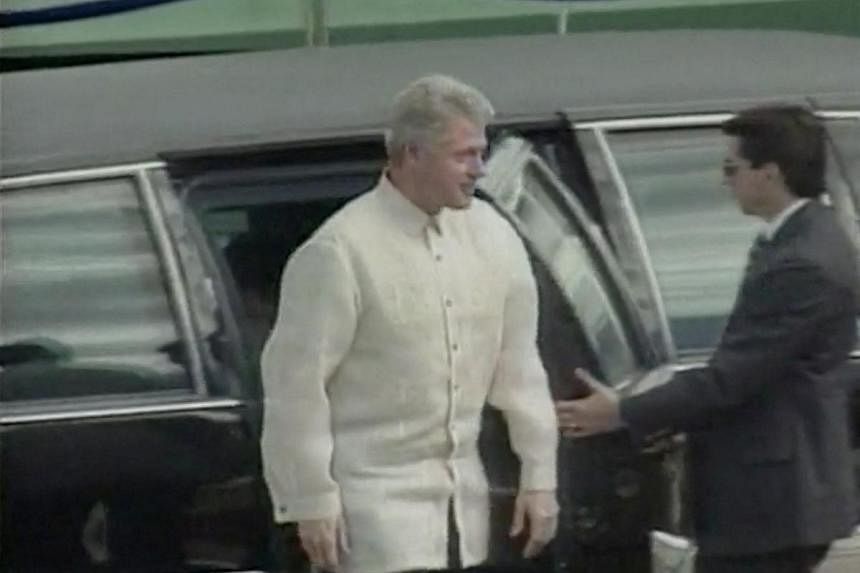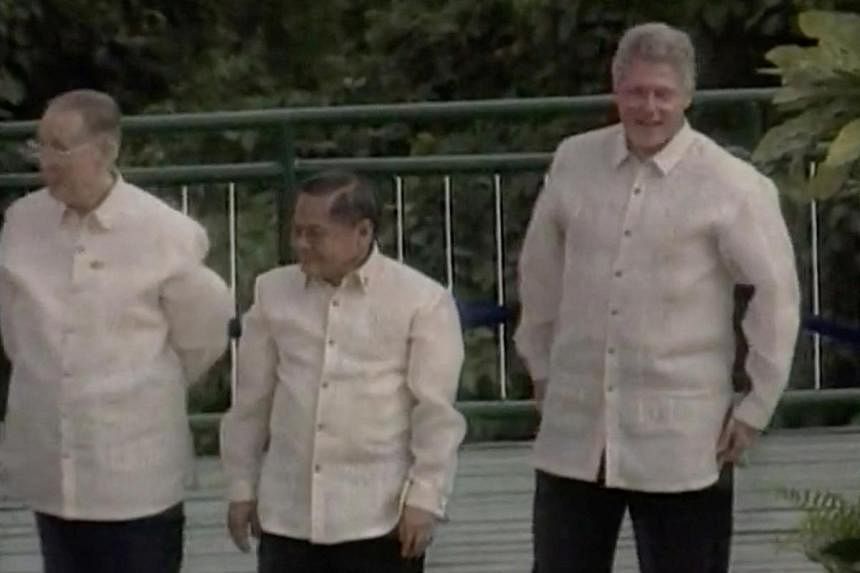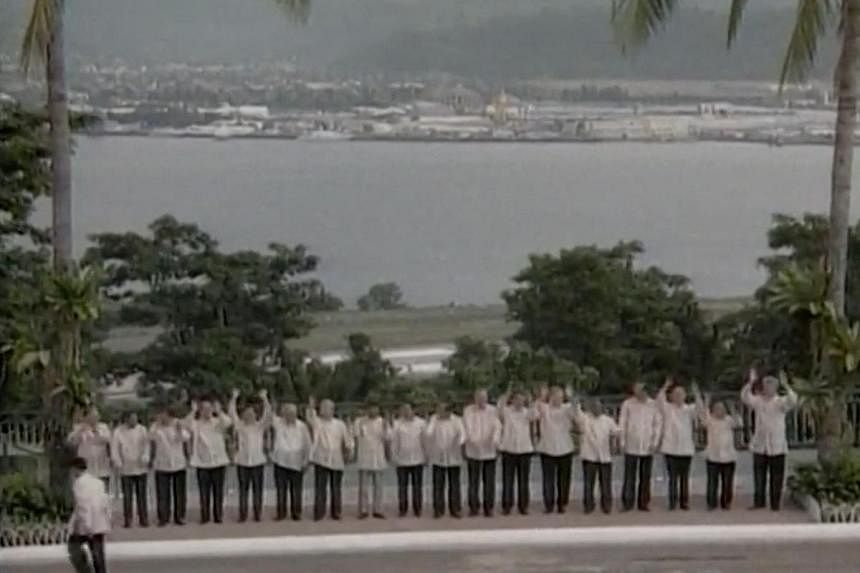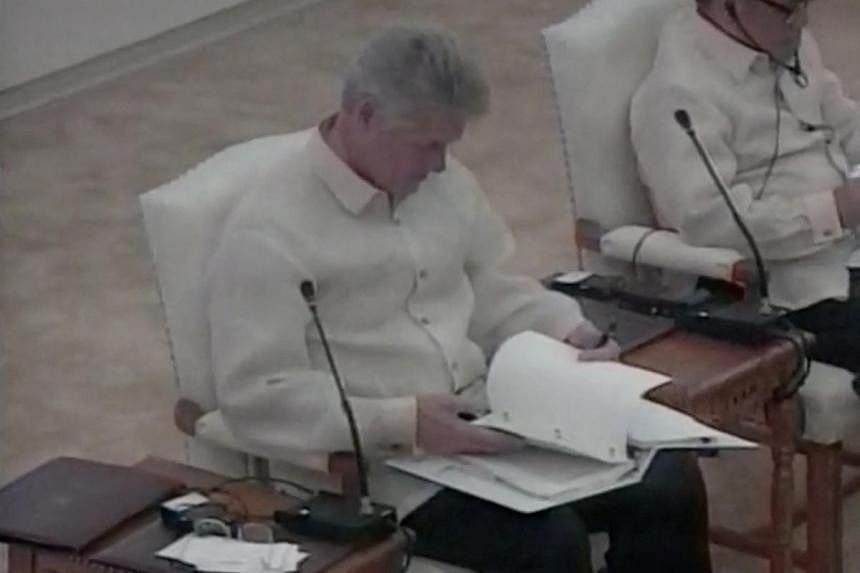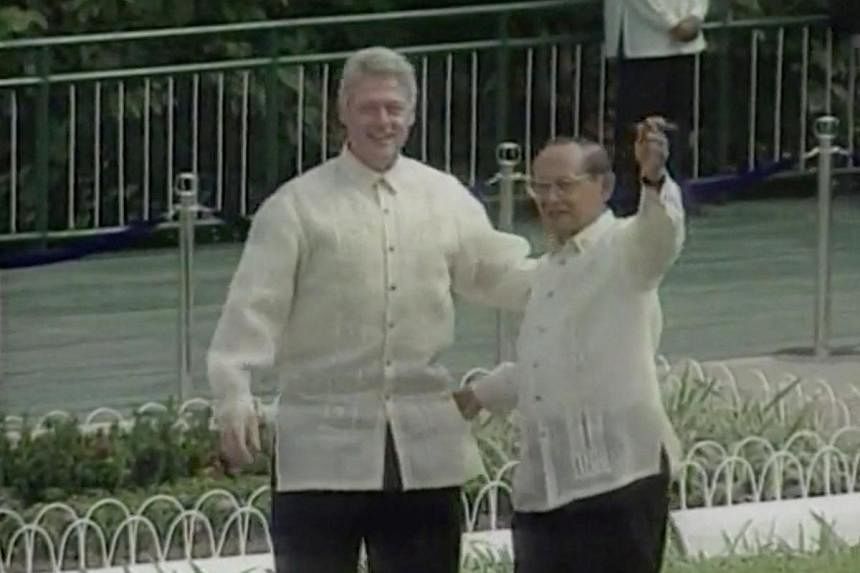WASHINGTON – Air Force One with then US President Bill Clinton and First Lady Hillary Clinton aboard was on its final approach to Manila on Nov 23, 1996, when their US Secret Service detail received alarming intelligence: An explosive device had been planted on the motorcade route into the Philippine capital.
Acting swiftly, the agents switched to a back-up route to the Clintons’ hotel, foiling a suspected Al-Qaeda attempt to assassinate the President of the United States minutes after his arrival for the annual Asia-Pacific Economic Cooperation (Apec) summit.
As the motorcade crawled along the traffic-clogged alternative route, Filipino security officers recovered a powerful bomb on a bridge the convoy would have taken, and a sport utility vehicle abandoned nearby containing AK-47 assault rifles, four retired agents told Reuters.
The assassination attempt, which appears to be one of terrorist organisation Al-Qaeda’s earliest attempts to strike the US, was mentioned briefly in books published in 2010 and 2019.
Now, eight retired Secret Service agents – seven of whom were in Manila – have given Reuters the most detailed account to date of the failed plot.
Reuters found no evidence of a US government investigation into the attempt on Mr Clinton’s life. The news agency also could not independently determine if intelligence agencies conducted classified probes.
For some of the Secret Service agents interviewed by Reuters, the events in Manila have left unanswered questions.
“I always wondered why I wasn’t kept back to stay in Manila to monitor any investigation,” said Mr Gregory Glod, the lead Secret Service intelligence agent in Manila and one of seven agents who spoke out for the first time. “Instead, they flew me out the day after Clinton left.”
“There was an incident,” said Secret Service spokesman Anthony Guglielmi. “It remains classified.” He declined to say what, if any, actions the United States took in response.
Mr Clinton did not respond to multiple attempts to reach him through his spokesperson and the Clinton Foundation.
Former Central Intelligence Agency (CIA) director Leon Panetta, who was Mr Clinton’s chief of staff at the time, said he was unaware of the incident but that an attempt to kill a president should be investigated.
“As a former chief of staff, I’d be very interested in trying to find out whether somebody put this information to the side and didn’t bring it to the attention of people who should have been aware that something like that happened.”
Under a 1986 law, it is a crime for a foreign extremist organisation to attempt to kill any US national overseas. Prosecution requires authorisation from the attorney-general – the late Janet Reno in 1996 – which would then trigger a Federal Bureau of Investigation (FBI) probe.
The FBI declined to comment on the Manila assassination attempt.
Four former US officials, including the ambassador in Manila at the time, Mr Thomas Hubbard, confirmed the foiled attack to Reuters but said they were also unaware of any US investigation or follow-up actions.
Thirteen years after Osama bin Laden’s death, Al-Qaeda is a diminished force. But the Oct 7, 2023, attacks on Israel by Hamas “mobilised efforts to radicalise and recruit new followers within Muslim communities in Europe”, a United Nations panel of experts wrote in a Jan 29 report, citing Al-Qaeda propaganda supporting Hamas.
Mr Glod said a US intelligence agency later assessed that the plot was set up at Osama’s behest by Al-Qaeda operatives and the Abu Sayyaf group, Filipino Islamists widely considered an arm of Al-Qaeda.
He declined to identify the agency. Reuters was unable to confirm the assessment, and the CIA declined to comment.
According to a 2022 International Crisis Group report, the Abu Sayyaf group is in disarray, with only a handful of its leaders still alive.
The office of the Philippines’ president, Department of Foreign Affairs and National Police did not respond to requests for comment.
Four of the Secret Service agents who spoke to Reuters noted that Ramzi Yousef – the Al-Qaeda-linked mastermind of the first US World Trade Centre attack in 1993 and a nephew of Sept 11 architect Khalid Sheikh Mohammed, who had trained Abu Sayyaf militants – was in Manila days before a 1994 visit by Mr Clinton.
Yousef is serving a life sentence plus 240 years in a federal “supermax” prison in Colorado.
An FBI memorandum of its first interview with Yousef after his 1995 arrest noted that he surveyed sites in Manila that the media reported Mr Clinton would visit. Yousef “indicated that he considered placing an improvised explosive device in a location along the motorcade route”, it said.
Yousef ultimately concluded there was too much security and insufficient time for an attack, the memo said.
Three of the Secret Service agents said they believed Yousef was instead preparing for the 1996 attack, pointing out that the date of the Apec summit was known in late 1994.
“I knew he (Yousef) was sort of an advance team,” said Mr Glod, citing his familiarity with intelligence reports.
Yousef’s lawyer, Mr Bernard Kleinman, told Reuters that while “it’s conceivable” that Yousef was in Manila in 1994 to begin the foiled 1996 plot against Mr Clinton, he doubted that he did, describing his client as a bragger who made “himself much, much greater than he may have actually been”.
The threat posed by Al-Qaeda and Yousef was just one of the unsettling elements confronting the Secret Service’s advance security team, the three agents recalled.
The Philippines was battling communist and Islamist insurgencies. Police discovered a bomb at Manila airport and another at the summit conference centre in Subic Bay several days before the Clintons’ arrival. The US State Department warned of threats against American diplomats in Manila the day before the Clintons flew in.
Mr Glod told Reuters the Manila assignment was “the worst advance I had ever done in terms of (threat) intel”.
The dangers were highlighted for Mr Clinton before the visit in top-secret President’s Daily Briefs, according to a military aide, retired US Air Force Lieutenant-Colonel Robert “Buzz” Patterson, who accompanied Mr Clinton on the trip.
It was late evening when Mr Clinton flew into Manila.
As Air Force One descended, Secret Service agent Daniel Lewis relayed the intelligence to the Secret Service team at the airport about a “device on a bridge” on the main route to The Manila Hotel.
Buckled into his seat outside the Clintons’ cabin, Mr Lewis Merletti, who led Mr Clinton’s protective detail and later became Secret Service director, said he came to the same conclusion after a call from a US intelligence officer whose name he did not know, warning of a communications intercept mentioning a “wedding across a bridge”.
He said he recalled an intelligence report several years earlier that identified “wedding” as “terrorist code for an assassination”. The planned motorcade route showed three bridges on the main route to the Clintons’ hotel.
“That’s it. We’re changing the route,” he remembered saying over a secure radio link to Mr Glod, who confirmed Mr Merletti’s recollection of the event.
The bomb intended for Mr Clinton was found atop an electrical box on a bridge along the original route, said Messrs Merletti, Lewis and Glod, who retired from the Secret Service in 1998, 2003 and 2011, respectively. Mr Glod was rehired in 2017 as a law enforcement instructor before leaving in October 2023.
Reuters video footage of Mr Clinton’s arrival shows bomb disposal experts wiring an explosive to the side of an electrical box on a bridge and detonating it. No bomb is seen atop the box.
Filipino security personnel also recovered a red Mitsubishi Pajero abandoned at the far end of the bridge, the agents said. They said the AK-47 assault rifles found inside suggested that the attackers planned to block the span of the bridge with the vehicle and fire on the motorcade.
The next morning, agents Glod and Merletti said they were briefed on the plot by a US intelligence official at the US embassy and shown photos of the device.
It comprised armour-piercing rifle-propelled grenades atop a box containing TNT wired to a Nokia phone rigged as a detonator, they said. Mr Lewis and Mr Craig Ulmer, who was the agent in charge of the Manila ground team, said they also later saw the photos.
Mr Dennis Pluchinsky, a retired State Department terrorism analyst who learnt of the foiled plot in 2020 while researching a history of anti-US terrorism, noted that in 1995, Mr Clinton issued Presidential Decision Directive 39 committing to “deter, defeat and respond vigorously to all terrorist attacks” against Americans at home or abroad, and “apprehend and prosecute” those responsible.
It was not until after 220 people died in Al-Qaeda bombings of the US embassies in Kenya and Tanzania in August 1998 that Mr Clinton responded with cruise missile strikes.
Those failed to stop Osama from planning fresh attacks. REUTERS
